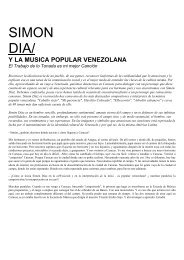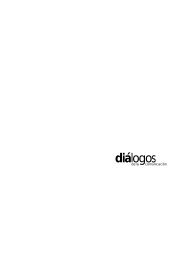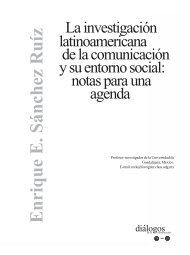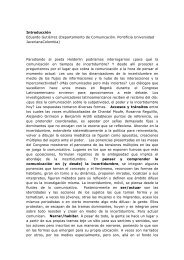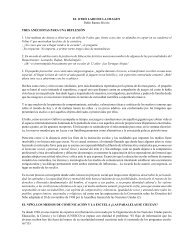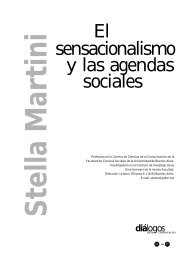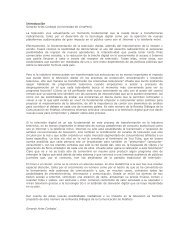Narrativas dibujadas - Diálogos de la Comunicación
Narrativas dibujadas - Diálogos de la Comunicación
Narrativas dibujadas - Diálogos de la Comunicación
Create successful ePaper yourself
Turn your PDF publications into a flip-book with our unique Google optimized e-Paper software.
REVISTA ACADÉMICA DE LA FEDERACIÓN<br />
LATINOAMERICANA DE FACULTADES DE COMUNICACIÓN SOCIAL<br />
ISSN: 1995 - 6630<br />
Análisis, síntesis y velocidad: <strong>la</strong> construcción <strong>de</strong> <strong>la</strong> secuencia en<br />
historieta como lugar <strong>de</strong> emergencia <strong>de</strong> <strong>la</strong> instancia <strong>de</strong> enunciación.<br />
Fe<strong>de</strong>rico Reggiani<br />
Argentina<br />
reggianicarut@gmail.com<br />
Tel: 02214704066<br />
Fe<strong>de</strong>rico Reggiani. Profesor en letras egresado <strong>de</strong> <strong>la</strong> Universidad Nacional <strong>de</strong> La P<strong>la</strong>ta. Es codirector <strong>de</strong>l proyecto <strong>de</strong> investigación<br />
―Mapa <strong>de</strong>l campo <strong>de</strong> <strong>la</strong> producción, edición y distribución <strong>de</strong> historietas realistas en Argentina‖, dirigido por el Dr. Roberto Von Sprecher<br />
(Universidad Nacional <strong>de</strong> Córdoba. Escue<strong>la</strong> <strong>de</strong> Ciencias <strong>de</strong> <strong>la</strong> Información). Ha publicado diversos artículos sobre historieta, así como<br />
guiones en medios como www.historietasreales.com.ar y Fierro.<br />
Resumen<br />
Todo montaje es una instancia enunciativa, en virtud <strong>de</strong>l sentido que produce <strong>la</strong> yuxtaposición <strong>de</strong><br />
elementos. La ca<strong>de</strong>na visual <strong>de</strong> <strong>la</strong> historieta es el producto <strong>de</strong> una enunciación, marcada por elecciones en<br />
cuanto a ritmos, grados <strong>de</strong> repetición o <strong>de</strong> elipsis, selección <strong>de</strong> momentos significativos y apuestas a <strong>la</strong><br />
transparencia o <strong>la</strong> exhibición <strong>de</strong> los recursos. La utopía <strong>de</strong> una enunciación transparente que niegue el<br />
significante enfrenta obstáculos notables en historieta, dado que existe una inevitable tensión entre <strong>la</strong><br />
página como totalidad plástica y <strong>la</strong> construcción <strong>de</strong>l re<strong>la</strong>to: <strong>la</strong> historieta propone imágenes articu<strong>la</strong>das por un<br />
eje temporal, pero dispone esas imágenes en coexistencia sobre un p<strong>la</strong>no. Sin embargo, <strong>la</strong> elección <strong>de</strong> un<br />
sistema <strong>de</strong> montaje "transparente", o su <strong>de</strong>svío, permite establecer tipologías sobre el régimen <strong>de</strong><br />
enunciación elegido, y su re<strong>la</strong>ción con tradiciones genéricas o estilísticas. Pue<strong>de</strong>n ais<strong>la</strong>rse dos formas<br />
básicas <strong>de</strong> <strong>de</strong>svío, <strong>la</strong> elipsis y el análisis: el borrado <strong>de</strong> momentos c<strong>la</strong>ve o su <strong>de</strong>scomposición en múltiples<br />
viñetas, y ambos funcionan como subrayados <strong>de</strong> <strong>la</strong> instancia <strong>de</strong> enunciación. Se analizan secuencias<br />
mínimas en tres historietas policiales pertenecientes a sucesivos estados <strong>de</strong>l campo: "Cayena" (Oesterheld<br />
y Haupt), "Savarese" (Wood y Mandrafina) y A<strong>la</strong>ck Sinner (Sampayo y Muñoz).<br />
Abstract<br />
Every montage is an enunciative instance: juxtaposition of elements produces sense. In comics, the visual<br />
chain is the product of an utterance, marked by choices in terms of rhythm, repetitions or ellipses, selection<br />
of significant moments and challenges to the transparency or the disp<strong>la</strong>y of resources. The utopia of a<br />
transparent enunciation <strong>de</strong>nying the significant facing remarkable obstacles in comics, given that there is an<br />
inevitable tension between the whole page as p<strong>la</strong>stic object and the construction of the story: comics<br />
propose images articu<strong>la</strong>ted by a time axis, but these pictures coexists on a p<strong>la</strong>ne. However, the choice of a<br />
system "transparent", or its <strong>de</strong>viation, are indications of the enunciation regime chosen, and their re<strong>la</strong>tionship<br />
to generic or stylistic traditions. It’s possible iso<strong>la</strong>te two basic forms of <strong>de</strong>viation: ellipsis and analysis, the<br />
erasure of key moments or the <strong>de</strong>composition into multiple panels, and both works as marks of the instance<br />
of enunciation. The article analyzes sequences of comics belonging to successive states of the field:<br />
"Cayena" (Oesterheld and Haupt), "Savarese" (Wood and Mandrafina) and A<strong>la</strong>ck Sinner (Muñoz and<br />
Sampayo).<br />
Fecha <strong>de</strong> recepción <strong>de</strong> artículo: 24/2/09<br />
Fecha <strong>de</strong> aceptación <strong>de</strong> artículo: 12/3/09<br />
1 DIÁLOGOS DE LA COMUNICACIÓN, N°78, ENERO - JULIO 2009



